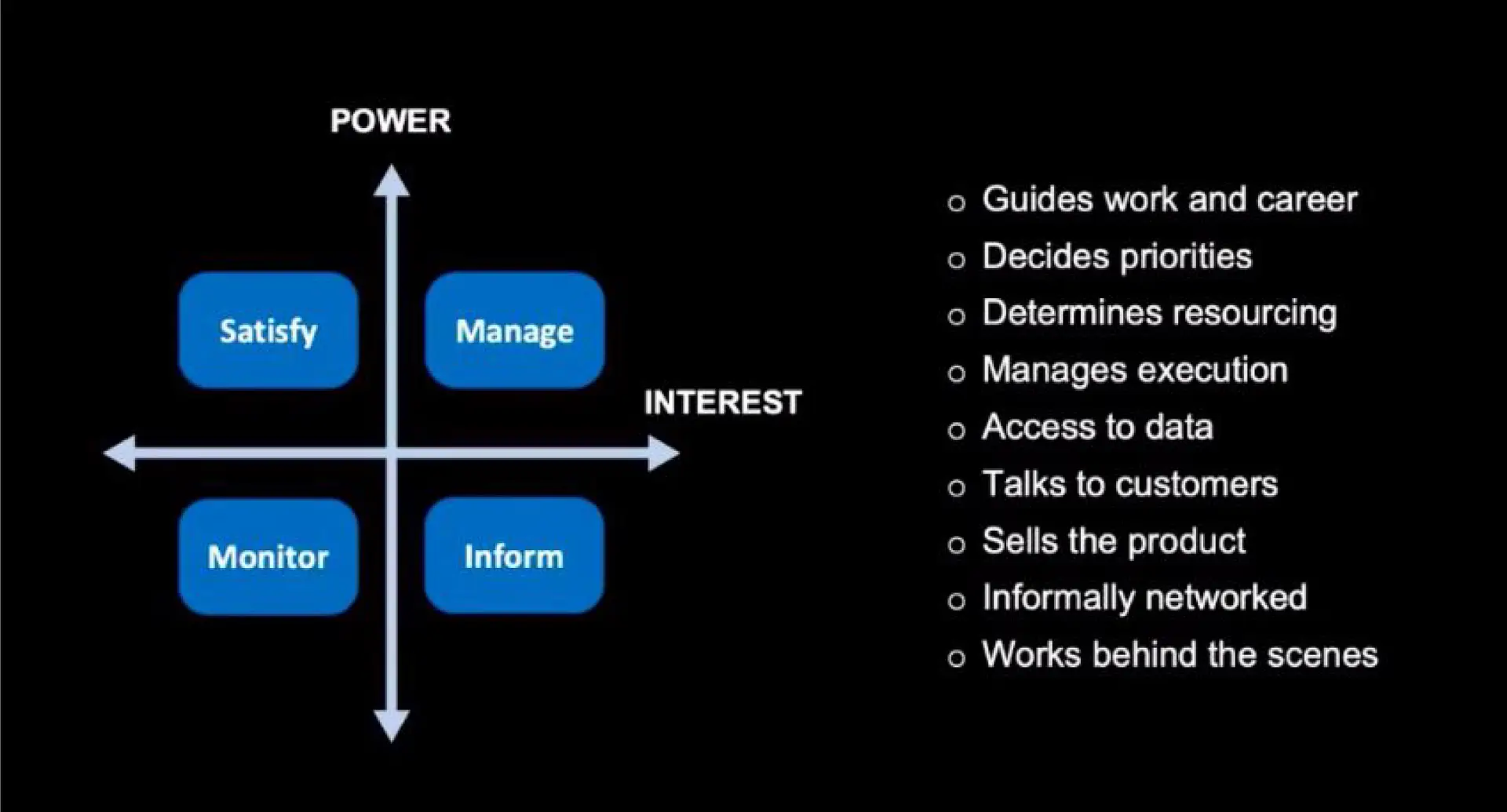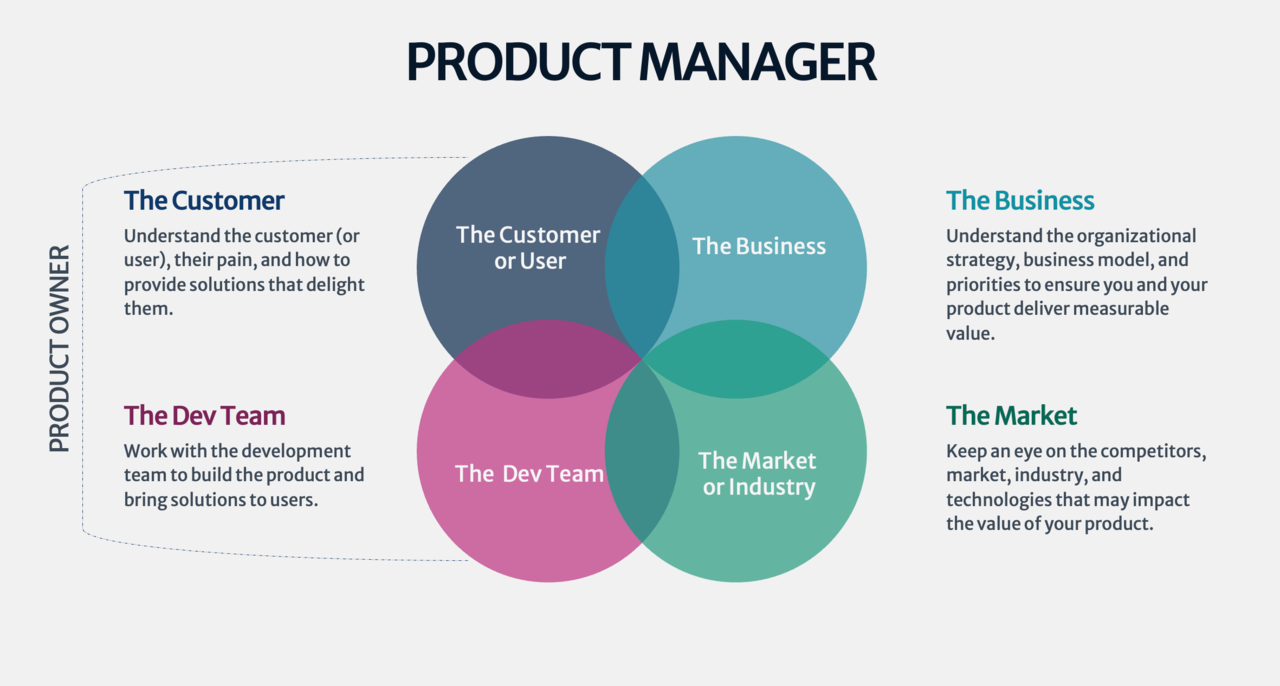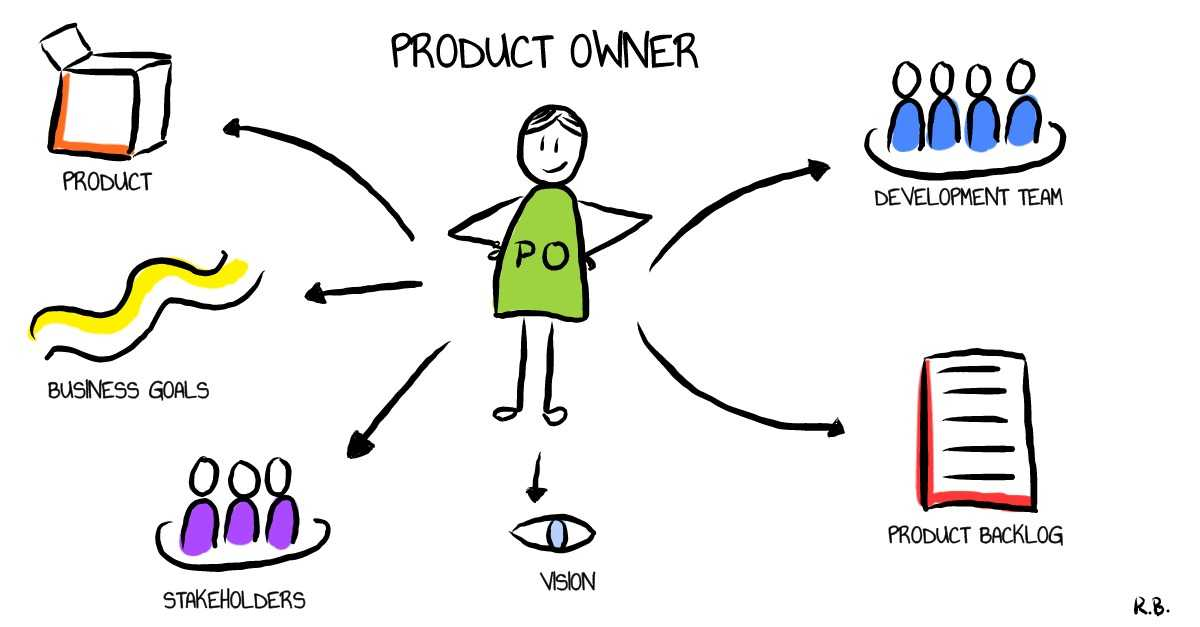In the dynamic realm of software development, the Agile methodology has emerged as a guiding light, illuminating the path to efficient and customer-centric product creation. At the heart of this methodology lies the pivotal role of the Product Owner.
In this comprehensive exploration, we delve into the essence of project management and ownership in Agile, tracing its significance in software development and beyond. This journey takes us through the principles, challenges, and practices that define effective product ownership, weaving together the threads that connect different industries.

Understanding Product Ownership
Product ownership forms the keystone of successful ventures, transcending industries and embodying the essence of customer-centric creation. This exploration delves into the intricacies of Product Ownership, dissecting its significance, responsibilities, and applicability to business leaders across diverse sectors.
Definition and Significance
At its core, the Agile and Product Owner role acts as the compass, steering development teams toward crafting solutions that genuinely meet user needs. This role entails more than simply dictating features; it’s about understanding the market, refining the product vision, and ensuring that every iteration aligns with approaches to identifying customer value.
Responsibilities and Tasks
The realm of Agile Product Owner encompasses an array of responsibilities, from meticulously grooming the product backlog to collaboratively guiding the development team in crafting a high-quality product. This is the individual who deciphers intricate user stories, ensures that features culminate into a valuable whole, and always has a pulse on the evolving demands of the market.
Role of Agile Principles
Agile principles are the guiding stars that shape the orbit of the Product Owner. By adhering to concepts such as continuous delivery, customer collaboration, and responding to change, the Agile Product Owner ensures that the development journey stays on course, leading to a product that is agile in its very DNA.

The Role of Product Owner in Software Development
Navigating the intricate landscape of software development, the role of the Product Owner stands as a beacon, guiding teams through the tumultuous seas of code and creativity. This exploration delves into the multifaceted responsibilities and profound influence that a product owner wields in the realm of software creation.
Collaboration with Teams and Stakeholders
The relationship between the Product Owner and the development team is not a monologue; it’s a symphony of ideas, communication skills, and understanding. Close collaboration ensures that every sprint is harmonized, and development is aligned with customer value. Equally vital is the engagement with stakeholders, a dialogue that paints a holistic picture of expectations and requirements.
Continuous Backlog Refinement
The product backlog is the palette upon which the Agile Product Owner paints. Regularly refining the backlog ensures that it remains a dynamic canvas that captures the evolving essence of the product. Prioritization, a crucial brushstroke, requires understanding the delicate balance between short-term goals and long-term vision.
Adapting to Change and Feedback
Agility is inherently tied to adaptability. The Agile Product Owner navigates the shifting tides of change, responding to new insights, and integrating customer feedback into the development process. Flexibility is the bedrock on which innovative solutions are sculpted.
Incremental Value Delivery
Gone are the days of waiting for the grand unveiling. The Agile Product Owner orchestrates a rhythm of incremental value delivery, crafting shorter development cycles that bring tangible value to customers. Each sprint delivers a masterpiece, refining and polishing the product with every iteration.

Overcoming Challenges in Product Ownership within Software Development
Within the dynamic realm of software development, the role of a Product Owner is akin to a tightrope walker navigating a complex circus of challenges. This exploration delves into the art of overcoming these challenges, revealing how adept Product Owner triumphs over the hurdles that dot their path.
Rapid Technological Evolution
Technology’s pace of evolution is akin to a sprinter on steroids. For the Agile Product Owner, keeping up means not only staying abreast of the latest trends but also predicting the trajectory of technological shifts to ensure the product remains relevant.
Balancing Technical Debt and Features
The lure of speed sometimes leads to accruing technical debt, a lurking challenge that can hinder future development. The Agile Product Owner finds the balance between delivering features promptly and maintaining the product’s long-term health.
Managing Stakeholder Priorities
Stakeholders often form a diverse chorus with conflicting desires. Navigating these competing priorities requires diplomatic finesse, a keen ear for underlying needs, and a pragmatic approach to prioritization.
Strategies for Collaboration and Communication
In the bustling realm of software development, clear communication can be as elusive as a mirage. The Agile Product Owner employs strategies such as regular stand-ups with a product manager, transparent documentation, and fostering a culture of open dialogue to ensure everyone is in tune.

Product Owner vs Product Manager
In the dynamic realm of product development, the roles and responsibilities of the Product Owner and Product Manager stand as integral pillars, each with distinct responsibilities and nuances. This exploration delves into the differences between these two pivotal roles, shedding light on their unique contributions to the creation and evolution of products.
Defining the Roles
A Product Manager holds the helm of the product ship, steering its strategic course. They focus on the big picture, aligning the product with business goals, market trends, and customer needs. On the other hand, a Product Owner is the architect of the product’s development journey. They delve into the nitty-gritty details, shaping the product backlog, guiding the development team, and ensuring that each iteration adds tangible value.
Strategic vs Tactical
While both roles interact with stakeholders, the focus differs. A Product Manager is the ambassador of the product to the world, crafting the vision, strategy, and positioning. In contrast, a Product Owner interfaces closely with the development team, translating the business strategy back into actionable tasks, guiding sprints, and ensuring the product’s evolution.

Market-Centric vs Development-Centric
Product Managers are market whisperers, deeply attuned to customer demands and industry trends. They analyze market data, define user personas, and prioritize product features that align with market needs. Every Product Owner, conversely, is a development advocate, driving the implementation process, clarifying requirements, and ensuring the development team’s alignment with the product vision.
Scope and Focus
A Product Manager juggles a broader scope, encompassing market analysis, competitive landscape, and overall product strategy. They guide the product’s trajectory from conception to market launch. In contrast to a product manager, a Product Owner operates with a narrower focus, diving into the execution details, and ensuring that each sprint delivers a working increment of the product.
Collaboration and Communication
While collaboration is essential for both roles, the spheres of collaboration differ. Product Managers liaise with executives, sales teams, and marketing to ensure alignment of the product roadmap with the company’s business goals. A Product Owner collaborates closely with the development team, clarifying requirements, providing feedback, and ensuring the product backlog is well-defined and actionable.
Extending Product Ownership beyond Software
While software development has long been the stage for the choreography of Product Ownership, this journey takes us beyond code and into uncharted territories where both the footprints of a product owner and product ownership leave an indelible mark. This exploration traverses the boundaries of industries, unveiling how the principles of effective product ownership extend their embrace beyond the realm of software.
Agile Adoption Beyond Software
The tentacles of Agile methodology have stretched beyond the confines of software development, infiltrating industries as diverse as manufacturing, marketing, and healthcare. This expansion has heralded the rise of Agile practices in previously uncharted territories.
Comparing and Contrasting Ownership Across Sectors
While the essence of product ownership remains constant, the context in which it operates shapes its manifestations. Comparing software development to other industries reveals both universal principles and unique adaptations that cater to specific needs.

Tailoring Agile Principles to Diverse Contexts
Adaptation is the cornerstone of Agile philosophy. As Agile spreads its wings across industries, it flexes and morphs to accommodate varied contexts. The Agile Product Owners toolkit evolves to address challenges unique to each sector.
Shared Principles and Industry-Specific Nuances
In the symphony of industries, the melody of Product Ownership harmonizes universal principles with the unique notes of individual sectors. This exploration delves into the interplay between shared principles and the nuanced symphonies that echo within diverse industries, showcasing how product ownership’s essence remains constant while adapting to the rhythm of each sector’s dance.
Unearthing Core Differences
Software development is a realm replete with technical intricacies, distinct from industries driven by physical products. Recognizing and appreciating these core differences is essential for harmonizing Agile principles across sectors.
Challenges Spanning Industries
Certain challenges transcend industry boundaries. Navigating the complexities of customer expectations, staying true to a product’s vision, identifying the customer first, and fostering a cohesive team are threads that weave through every sector.
Lessons from Software Development
Drawing from the wellspring of software development, industries across the board extract valuable lessons. The Agile mindset’s potency, the efficacy of iterative cycles, and the power of collaboration are transferable gems.
Learning from Software Development for Industry Applications
The crucible of software development has birthed a treasure trove of wisdom, a reservoir from which other industries draw inspiration. This exploration unveils the gems that software development offers, showcasing how its lessons transcend code and reverberate within diverse sectors, enriching their journeys of Industry Applications.

Unveiling Successful Agile Methodology
Software development stands as a trailblazer, having paved the way for Agile methodologies. The efficacy of practices like user stories and backlog and project management shines as beacons, guiding industries in their Agile endeavors.
Adapting Tools and Techniques
Agile tools are universal translators, converting principles into actionable steps. Techniques such as user stories, once confined to code, now find resonance in industries where products span beyond lines of code.
Case Studies of Agile Beyond Software
Real-world examples breathe life into theory. We explore case studies where Agile has transcended the digital sphere, yielding success stories in fields as varied as fashion, automotive, and education.
Best Practices for Product Ownership Across Industries
In the symphony of industries, the role of Product Ownership takes on various forms, yet the underlying principles of success remain consistent. This exploration unveils a harmonious melody of best practices that traverse sectors, showcasing how effective product ownership resonates universally while adapting to the nuances of each industry.
Defining Vision and Goals
Every ship needs a North Star. The Agile Product Owner steers with a well-defined product vision and goals that not only guide development but resonate with the desires of end-users.
Cultivating a Culture of Collaboration
Agile’s spirit is rooted in collaboration. Creating an ecosystem where cross-functional teams interact seamlessly and customer and stakeholder needs and inputs are treasured creates a fertile ground for product success.
Prioritizing Flexibility and Adaptability
Agile thrives on change. Industries embracing product ownership cultivate a flexible mindset, allowing the product to morph in response to emerging insights.
Embracing Iterative Learning
Continuous improvement is Agile’s heartbeat. Industries that flourish embrace the ethos of learning from each iteration, sculpting products that evolve in tune with customer needs.
Embracing Future Trends in Product Ownership
The landscape of Product Ownership is a dynamic canvas that evolves with time. As industries stride forward, embracing innovation and change, this exploration dives into the realm of future trends, unveiling how the horizon of product ownership transforms and reshapes itself to meet the demands of tomorrow.

Anticipating Evolution
Agile is a living organism, evolving as industries transform. Proactive industries anticipate the next evolution, staying ahead of the curve by embracing emerging trends in Agile philosophy.
Integrating Technological Advancements
Technology catalyzes change across industries. Integrating cutting-edge tools and methodologies fuels Agile methods, streamlining product ownership across sectors.
Preparing for the Next Phase
As Agile’s journey continues, industries brace for the next chapter. The agility that once revolutionized software development now becomes the lodestar guiding diverse sectors into uncharted territories.
Conclusion
In summary, our journey has explored the world of product ownership, revealing its vital role in software development and how it’s making waves across different industries. The Agile Product Owner isn’t just a small part; it’s like the heart of crafting exceptional products, important not only in software but also in areas like manufacturing.
Furthermore, there’s a clear message that industries should come together to learn from each other in their quest to create value. These Agile principles aren’t limited to specific sectors; they offer a unified way of approaching product ownership that can benefit everyone who adopts them.
FAQs
Why Agile is most associated with product development?
Agile’s association with product development stems from its emphasis on iterative and customer-focused approaches. This methodology thrives in the dynamic, rapidly changing environment of product creation, allowing teams to adapt to evolving user needs efficiently. Its iterative cycles and collaborative nature align well with the iterative nature of product development, making it a natural fit.
How is agile different from other software development techniques?
Agile stands apart from traditional software development approaches by prioritizing flexibility, customer collaboration, and incremental progress. Unlike rigid methodologies, Agile adapts to changing requirements and integrates feedback in short cycles. Traditional methods often follow a predefined plan, while Agile promotes continuous improvement and welcomes changes throughout the development process.
Which industries can benefit from applying Agile?
Virtually any industry can benefit from applying Agile principles. While it originated in software, Agile’s adaptive nature translates well to fields like manufacturing, marketing, healthcare, and more. Any sector aiming for value creation, faster time-to-market, and customer-centric solutions can harness the benefits of Agile methodologies.
Who is usually the product owner in Agile?
In Agile, the Product Owner is a pivotal role responsible for defining and prioritizing the product backlog, ensuring alignment with customer needs and technical capabilities, and communicating requirements to the development scrum team. They act as the bridge between stakeholders and the scrum team, making critical decisions to maximize the product’s value and market impact.
What is the difference between a Product Owner and Agile Product Owner?
The term “Agile Product Owners” specifically refers to the Product Owner role within Agile methodologies like Scrum. A broader “Product Owner” title might encompass similar roles in non-Agile contexts or industries. The key distinction lies in the context: “Agile Product Owners” is a specialized role within Agile frameworks.
What does Product Owner mean in Scrum?
In a Scrum team, the Product Owner is a pivotal role responsible for maximizing the value of the product. They define and prioritize items in the product backlog, ensuring they align with customer needs and business objectives. The Product Owner is the bridge between stakeholders and the development scrum team, making crucial decisions and guiding the team to create a valuable product.



